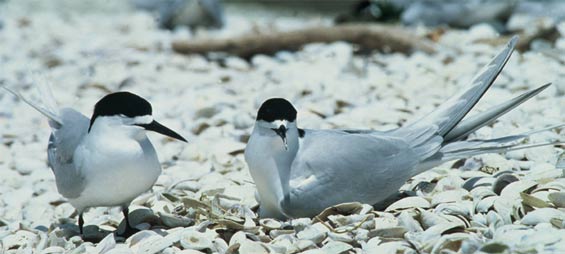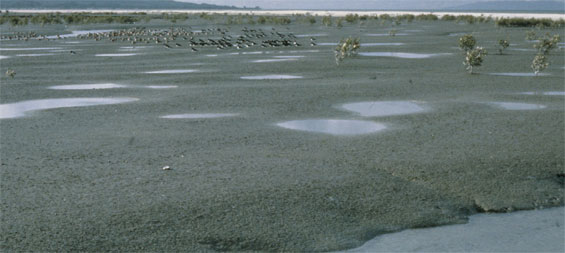Ramsar site no. 459, listed on 29 January 1990
Location: 52 km southeast of Auckland
The shallow tidal flats of the Firth of Thames/Tikapa Moana exposed at ebb tide cover approximately 8,500 hectares and include shallow estuarine water and mudflats, shell banks, grass flats, mangrove forest, salt marsh and limited freshwater swamp margins.
The shell banks between Miranda and Kaiaua are an example of a Chenier plain, a unique landform rare globally. They are composed principally of the fossilised shells of cockle Austrovenus stutchburyi. These shell banks, as well as grass flats, are used as high tide roosts by many birds.

White-fronted tern pair nest on the shell bank
The intertidal mud and sand flats extending from Thames to Miranda offer extensive feeding opportunities for wader and waterfowl and the flourishing and expanding mangrove and salt-marsh communities buffering the sea from the land, provide alternative habitats for rails and nursery areas for marine fish.
The Firth of Thames is one of New Zealand’s three most important coastal stretches for shorebirds. Seventy four species, many rare or uncommon, have been recorded at this site.
These include one grebe, five cormorants, four herons, one spoonbill, seven members of the Anatidae family, one gallinule, two oystercatchers, six plover, 27 members of the Scolopacidae family (curlews, whimbrels, godwits, snipes and sandpipers), two stilts, two skuas and seven gulls and terns.
Most of the bird species using the intertidal mud and sand flats or adjacent shallow waters are migratory, a large proportion coming from the Northern Hemisphere to spend their winter season (New Zealand summer) in the Firth of Thames.

Waders at Miranda
The most abundant species are the Eastern bar-tailed godwit (Limosa lapponica baueri) from the Arctic and Lesser knot (Calidris canntus canntus) from Siberia. Some endemic species which breed in the South Island such as the SI pied oyster catcher (Haematopus ostralegus finschii), pied stilt (Himantopus himantopus leucocephalus) and wrybill (Anarhynchus frontalis) winter over in the Firth of Thames. NZ dotterel (Charadrius obscurus) and black stilt (Haimantopus novaezelandiae), both of which are endangered, regularly visit the area in small numbers and the dotterel is known to nest at Miranda.
The average number of waders present in the area over the year is 25,000 while the total number present may peak at as many as 40,000 migratory birds during the summer months.
The Firth of Thames provides an important fishery of local significance with flounder and snapper the main species caught as well as incidental catches of other species such as sandshark.
The Ramsar site of 8,927 hectares lies within the Crown administered Coastal Marine Area with jurisdiction vested in LINZ, Waikato Regional Council and Department of Conservation. It is subject to a claim by Hauraki Maori under the Treaty of Waitangi. Historically, Hauraki Maori lived predominantly on the fertile lowlands along the coast and waterways and the Firth was an important site for gathering both fish and waterfowl.
The Hauraki Gulf Marine Park Act 2000 recognises the national significance of the Hauraki Gulf by establishing a marine park encompassing the waters of the Gulf (including the Firth of Thames), the foreshore and seabed within the Gulf and all publicly owned reserves located on the islands of the Gulf. It also established the Hauraki Gulf Forum comprising representatives from iwi and from central and local government agencies with statutory responsibilities for managing use, development and conservation within the park and its catchments and to coordinate and to oversee implementation of the Act.
The Miranda Naturalists Trust operates a Shorebird Information Centre at Miranda which is used for educational purposes and promotion of research. The Trust and Ornithological Society have undertaken regular bird counts in the area since the 1940s.